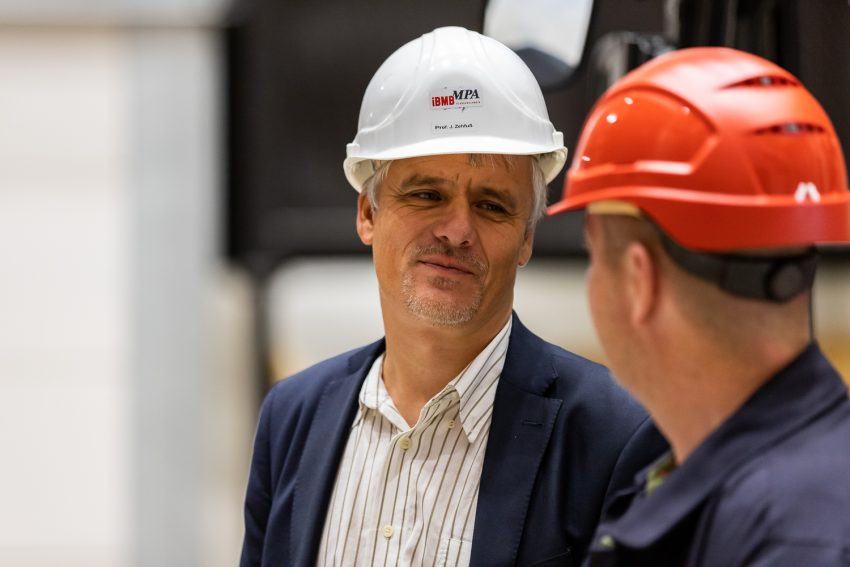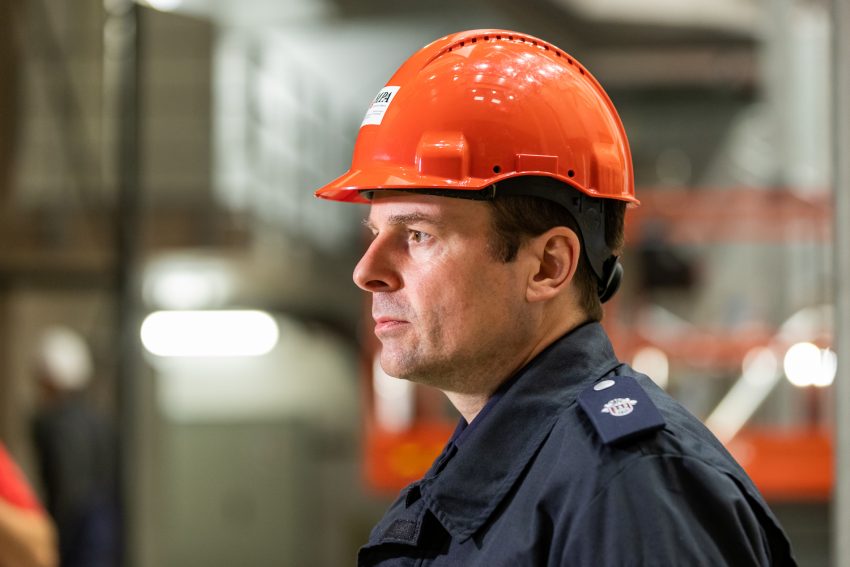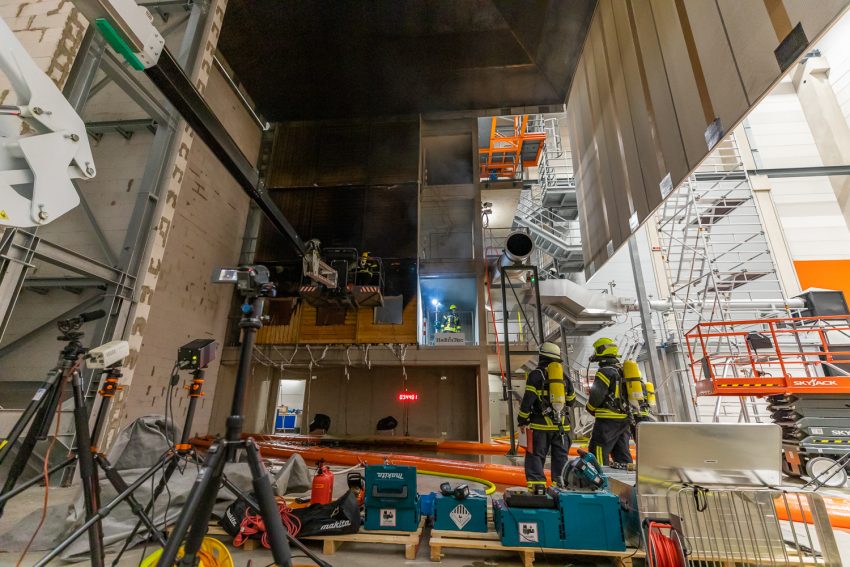Research on Fire Successful first large-scale fire test at the Centre for Fire Safety Research
The flames blaze high up on the wooden facade. In a few minutes, they spread to another floor. Thick smoke fills the air around the building. Fortunately, the full-scale fire in the four-storey building is an experiment. The first large-scale experiment in the test hall of the new Centre for Fire Safety Research (ZeBra) at Technische Universität Braunschweig. Behind the dark façade of the research building on Campus East, the scientists can research the fire behaviour of new types of construction using renewable raw materials and products of the energy transition and thus contribute to improved fire safety so that even more timber construction will be possible in cities in the future.

How does a fire develop on such a façade and what influence do insulating materials made from renewable raw materials have on fire fighting? Photo credit: Kristina Rottig/TU Braunschweig
On the day of the test, the tension between the scientists and the firefighters is palpable. Will the fire on the first floor spread through the window openings to the outer wall and façade as planned? Are all the measuring instruments working? When is the right time to start extinguishing the fire? And what is the best way to extinguish the fire?

Professor Jochen Zehfuß, spokesman for the Center for Fire Research (ZeBra). Photo credit: Kristina Rottig/TU Braunschweig
The fire house in the test hall has been prepared for the full-scale experiment over the past few days. On three floors of the four-storey façade test stand, the staff of the Centre for Fire Research have installed a wooden façade – using different constructions: The open wooden formwork is arranged vertically on one side and horizontally on the other two. Horizontal sheet metal fire barriers have also been inserted, as required by the model timber construction guideline. Behind the wooden façade are various types of insulation made from renewable raw materials: Wood fibre, algae and hemp. The cladding is separated from the insulation by a rear ventilation gap and a gypsum fibre board. This allows moisture to be easily removed. “But in the event of a fire, this is of course critical, because the flames can penetrate and possibly create a chimney effect, i.e. the fire is additionally fanned,” explains Professor Jochen Zehfuß, head of the Centre for Fire Safety Research.
More and more multi-storey buildings made of wood
The partners in the HoBraTec research project, including the Hamburg Fire Brigade, wanted to find out how a fire develops on such a façade and what influence insulating materials made from renewable raw materials have on firefighting. And, of course, how best to extinguish fires on wooden facades at great heights and inside wooden structures. Insulating materials made from renewable raw materials, which are not yet permitted in most German states for use in load-bearing or room-enclosing components of larger buildings, can smoulder within the structure and release large quantities of toxic gases. However, such fires are difficult to detect and therefore difficult for the fire brigade to extinguish. The new Centre for Fire Research therefore offers the best opportunity to verify findings from small and medium scale tests on a 1:1 scale.

Alexander Wellisch, project manager at the Hamburg Fire Department. Photo credit: Kristina Rottig/TU Braunschweig
These trials are important for the fire service because timber construction is becoming increasingly important in urban areas. Only a few years ago, the building regulations were changed to allow buildings up to 22 metres tall to be made of wood. “This fundamentally changes the framework conditions for the fire brigade,” says Alexander Wellisch, project manager for the Hamburg fire brigade. “In addition to a higher fire intensity, the development of fires within the construction is increasingly to be expected. Especially when using insulation materials made from renewable raw materials, which are increasingly in demand in the context of sustainability, we expect that fires within structural components will be difficult to detect. We want to use the knowledge gained from the HoBraTec research project to optimise fire-fighting methods and techniques for modern timber buildings”.
Large-scale test facility unique in Europe
The partners in the HoBraTec research project (Magdeburg-Stendal University of Applied Sciences, Heyrothsberge Institute for Fire and Disaster Prevention, Hamburg Fire Brigade) have been working together with the Institute for Building Materials, Solid Construction and Fire Protection for many years. The Centre for Fire Safety Research offers ideal conditions for their investigations: ZeBra is unique in Europe, with a façade test stand up to twelve metres in height and a large calorimeter for open-air fire tests, for example on electric vehicles, buses or high-voltage storage systems. Here, full-scale fires with a heat release rate of up to 20 megawatts can be simulated, measured in detail and analysed. The fire power of the wooden façade test was around ten megawatts. By comparison, conventional cars release around five megawatts of heat in a fire.
In order to carry out such fire experiments in a closed experimental hall, the fumes have to be collected. Before the experiment, a giant extraction hood is moved towards the burning house. At up to 70 cubic metres per second, the twelve-by-twelve-metre hood sucks in and filters the fumes. The scientists can analyse the released gases via measuring sections in the flue gas flow and draw conclusions about the heat release rate via the oxygen reduction.
From Experiment to Simulation Model
All the thermophysical and chemical parameters recorded are later used as input data for simulation models. “In addition to experimental research, our goal is to improve the models that predict the course of a fire. Such large-scale experiments are of course spectacular, but they are also very expensive and time-consuming,” says Professor Zehfuß.
That’s why the scientists installed measuring instruments in the room on the first floor where the fire is lit, for example, to record the temperature at various points and to be able to detect the heat development. “Flowmeters were also installed at the window openings to measure the speed at which air enters and exits the fire,” explains principal investigator Jan-Gabriel Scheller. A total of 530 sensors were installed for the two two-day tests.
New fire safety requirements
That day, a fire was set on three wooden cribs. The fire quickly became visible in the windows, spread through the window openings to the wooden façade and finally engulfed the façade on the first floor. The firefighters waited for about half an hour before starting their operation. This is the time it would take for the fire to be extinguished in reality. Even though the Hamburg fire brigade is supposed to arrive at the scene within eight to twelve minutes of the alarm being raised, the 30-minute period before the fire is extinguished has to be taken into account, as the rescue of people is the first priority.

Finally, firefighters penetrate the exterior wall with a new type of drill extinguisher and spray firefighting foam to end any last smoldering fires. Photo credit: Kristina Rottig/TU Braunschweig
First, the firefighters open the door to the room on the first floor where the fire started and extinguish it with water. From the outside, they use a conventional nozzle to extinguish the façade. Finally, the firefighters penetrate the outer wall with a new type of drill extinguisher and spray foam into the so-called rear ventilation level to extinguish the last smouldering fires. After about an hour and a half, the firefighting efforts are complete, but the mission is not over for the eight firefighters. Now it is time to open up the components to study the effects of the fire. The partners in the HoBraTec research project will evaluate the test: What needs to be considered in such a fire involving insulation materials made from renewable resources? How can it best be detected and extinguished? Since urban timber construction is also becoming very popular in Hamburg, with entire districts being planned in timber construction, the Hamburg Fire Brigade would like to be as well prepared as possible for the expected scenarios. “We also want to investigate the limits of fire-fighting operations in order to be able to determine the requirements for preventive fire protection more precisely,” says Alexander Wellisch.
These are also important issues for the Centre for Fire Safety Research. With all the changes in construction, such as the increased use of renewable raw materials, new digital construction methods and innovative energy storage in buildings, fire safety must of course also be guaranteed.
Around ten large-scale tests will take place at ZeBra every year. The next one is already scheduled for November – with other application technologies.
